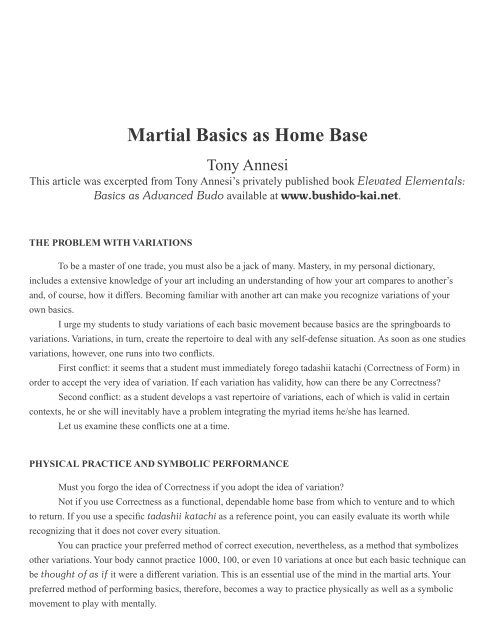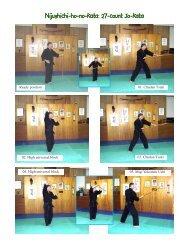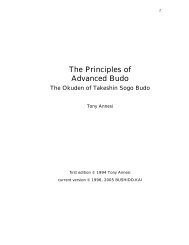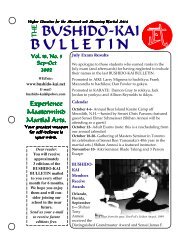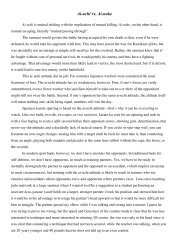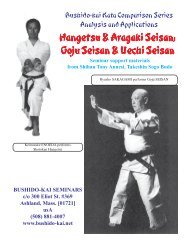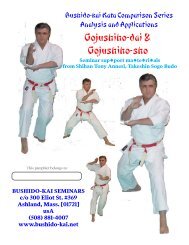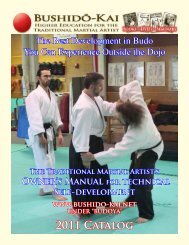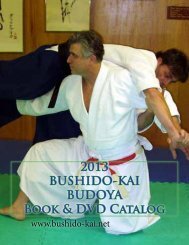Martial Basics as Home Base - Bushido-Kai
Martial Basics as Home Base - Bushido-Kai
Martial Basics as Home Base - Bushido-Kai
Create successful ePaper yourself
Turn your PDF publications into a flip-book with our unique Google optimized e-Paper software.
<strong>Martial</strong> <strong>B<strong>as</strong>ics</strong> <strong>as</strong> <strong>Home</strong> B<strong>as</strong>e<br />
Tony Annesi<br />
This article w<strong>as</strong> excerpted from Tony Annesi’s privately published book Elevated Elementals:<br />
<strong>B<strong>as</strong>ics</strong> <strong>as</strong> Advanced Budo available at www.bushido-kai.net.<br />
THE PROBLEM WITH VARIATIONS<br />
To be a m<strong>as</strong>ter of one trade, you must also be a jack of many. M<strong>as</strong>tery, in my personal dictionary,<br />
includes a extensive knowledge of your art including an understanding of how your art compares to another’s<br />
and, of course, how it differs. Becoming familiar with another art can make you recognize variations of your<br />
own b<strong>as</strong>ics.<br />
I urge my students to study variations of each b<strong>as</strong>ic movement because b<strong>as</strong>ics are the springboards to<br />
variations. Variations, in turn, create the repertoire to deal with any self-defense situation. As soon <strong>as</strong> one studies<br />
variations, however, one runs into two conflicts.<br />
First conflict: it seems that a student must immediately forego tad<strong>as</strong>hii katachi (Correctness of Form) in<br />
order to accept the very idea of variation. If each variation h<strong>as</strong> validity, how can there be any Correctness?<br />
Second conflict: <strong>as</strong> a student develops a v<strong>as</strong>t repertoire of variations, each of which is valid in certain<br />
contexts, he or she will inevitably have a problem integrating the myriad items he/she h<strong>as</strong> learned.<br />
Let us examine these conflicts one at a time.<br />
PHYSICAL PRACTICE AND SYMBOLIC PERFORMANCE<br />
Must you forgo the idea of Correctness if you adopt the idea of variation?<br />
Not if you use Correctness <strong>as</strong> a functional, dependable home b<strong>as</strong>e from which to venture and to which<br />
to return. If you use a specific tad<strong>as</strong>hii katachi <strong>as</strong> a reference point, you can e<strong>as</strong>ily evaluate its worth while<br />
recognizing that it does not cover every situation.<br />
You can practice your preferred method of correct execution, nevertheless, <strong>as</strong> a method that symbolizes<br />
other variations. Your body cannot practice 1000, 100, or even 10 variations at once but each b<strong>as</strong>ic technique can<br />
be thought of <strong>as</strong> if it were a different variation. This is an essential use of the mind in the martial arts. Your<br />
preferred method of performing b<strong>as</strong>ics, therefore, becomes a way to practice physically <strong>as</strong> well <strong>as</strong> a symbolic<br />
movement to play with mentally.
Examples of<br />
variation from<br />
karate: 6 ways<br />
to perform an<br />
inside middle<br />
block:<br />
ABOVE:<br />
01A & B.<br />
hanmi<br />
(half-body);<br />
LEFT: 02A & B.<br />
nino-uke<br />
(parry/block);
03A & B.<br />
makko<br />
(square);<br />
04A & B.<br />
oshi<br />
(pushing);<br />
05A & B.<br />
hiki<br />
(pulling);
06A, B, & C.<br />
me-ni meinai<br />
(invisible).<br />
An example of variation from Aiki: 4 ways to perform kao-ate:<br />
07A & B. pull;
08A & B. elbow push;<br />
09A & B. arm circle<br />
10A & B. circle with hips.
You can turn this mental practice into physical practice when you have the time or the inclination to<br />
“realize” the perceived variations. You then apply the symbolic b<strong>as</strong>e-movement in one or more of its concrete<br />
variations. In other words, formal practice takes a specific stylistic form while informal application uses<br />
variations b<strong>as</strong>ed on that specific form.<br />
Even if you do not “play” with your b<strong>as</strong>ics, your art’s kata or pre-arranged waza provide many possible<br />
variations. A kata’s numerous adjustments to b<strong>as</strong>ics force you to realize certain variations every time you<br />
perform a kata correctly. You discover further subtle variations a certain kata may not illustrate simply by<br />
applying any of the newly realized techniques against different opponents. This is one of the many unrecognized<br />
values of kata practice for self-defense.<br />
Heian Nidan’s<br />
first movement is<br />
actually a variation<br />
of an upper block<br />
(11A-ABOVE LEFT)<br />
or inside middle<br />
block (11B-ABOVE<br />
RIGHT), an outside<br />
middle block (12A-<br />
MIDDLE LEFT) and<br />
close punch (12B-<br />
MIDDLE RIGHT),<br />
and a down block<br />
(13-BELOW<br />
RIGHT).<br />
CH-CH-CH-CHANGES<br />
Turn and face the strange. How you perform a technique<br />
depends on the situation, the environment, the opponent, the context,<br />
and the goal.
Ude otosu odori a.k.a. ikkyo(14A-<br />
G.) h<strong>as</strong> variations in nuki otosu<br />
odori (15A-D, NEXT PAGE) and<br />
uchikomi odori (16A-D, SECOND<br />
PAGE FOLLOWING).<br />
Would you throw the exact same upper block/reverse punch combination against an overhead clubbing<br />
attack <strong>as</strong> against a looping right hand? Would the angle be the same? Would the proximity to the opponent be<br />
identical?<br />
What if you were standing on a hardwood floor or a craggy ledge? Would your stance be the same in<br />
both circumstances? How about on ice or in mud?<br />
What if your attacker were a 310-pound trucker or a 180-pound sprinter?<br />
What if the antagonist were drunk? Vicious? Kidding around? On drugs? Would your block be the same<br />
in every instance?<br />
What if you wanted to subdue the opponent? Knock him away? Knock him out?<br />
Would you not adjust on the fly, taking into account <strong>as</strong> many variables <strong>as</strong> you could?
Nuki otosu odori (15A-D)<br />
THE SPECIFICITY OF CHANGE<br />
Let us take the details of each technique above and illustrate how these may change at a higher level.<br />
“At a higher level” is a subjective judgment, of course. Here are three ways (among others) a technique may be<br />
adjusted “at a higher level”:<br />
(1) the shape may change,<br />
(2) the technique may be intentionally “mis-timed” or “mis-distanced” (so it is not misapplied at all), and<br />
(3) the “negative” <strong>as</strong>pect of technique may be used.<br />
Now, <strong>as</strong>k yourself if you could learn each of the movements of Heian 2, for example, with each variation<br />
<strong>as</strong> a specific rank requirement. That would be a lot of material to cover. Even if you could learn the types of<br />
variations suggested above, could you learn variations of those variations? At some point, the requirements
Uchikomi odori (16A-D.<br />
for that rank would become rather burdensome. Too many concretes are too difficult to learn one at a time. To<br />
smooth out and speed up the learning process, you have generic movements that suggest most of the possible<br />
variations you can discover. These generic movements are called b<strong>as</strong>ics.<br />
The fundamentals give us the faculty to quickly learn a myriad of variations to adapt to each new<br />
situation. As Chojun Miyagi the founder of Goju karate once said of traditional kata (y’know, that rigid,<br />
stuffy practice with no practical application): “Kata are not simply exhibitions of form, they are concrete<br />
manifestations of techniques that can be transformed at any time to any form at will and in which the essence of<br />
karate h<strong>as</strong> <strong>as</strong>sumed a definite form.” The same holds true for the b<strong>as</strong>ics from which kata are constructed.
(1) a shape change in the opening of Kata<br />
Heian 2:<br />
> to strike an opponent’s fist with an<br />
intercepting elbow (17A, B)<br />
> to parry while punching (17C, LEFT)<br />
> to elbow strike and punch simultaneously (17D, RIGHT)
(2) a mis-timed or mis-distanced<br />
technique from the opening of Kata<br />
Heian 2:<br />
> use <strong>as</strong> block and side strike to head<br />
(18A, B, & C)<br />
With enough experience in variation, you begin to develop a repertoire for practical use. Soon that<br />
repertoire gets too big to employ effectively. It is too difficult to choose a variation from thousands of<br />
possibilities let alone try to choose one instantaneously for practical application, but your study of applied<br />
b<strong>as</strong>ics and their variations at an advanced level h<strong>as</strong> brought you to the study of principles, the next stage in your<br />
development. Principles help you organize and understand the variations you have developed all of which are<br />
symbolized by your art’s preferred set of b<strong>as</strong>ics.
(3) a “negative” <strong>as</strong>pect of the opening of Heian 2 or Heian 4:> receive a punch after<br />
the initial movement of the kata and lower arms resulting in a takedown like aiki’s ikkyo<br />
(19A-D)


